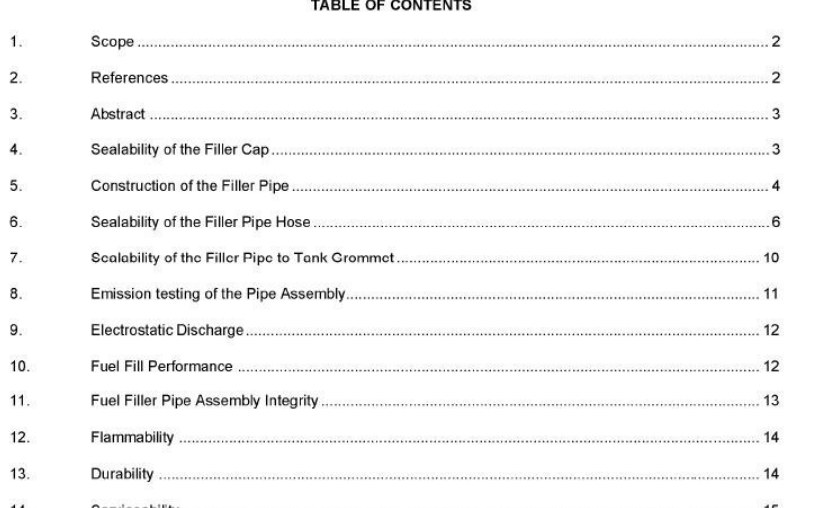SAE J2599:2002 pdf download Fuel Filler Pipe Assembly Design Practice to Meet Low Evaporative Emission Requirements
3Abstract—Design of clamped hose and elastomeric grommet sealed filler pipe joints is not an exact science;
therefore, precise formulas and methods cannot accurately predict performance. However,theoretical andphilosophical constructs based on empirical data and industry experience can be used to develop standardpractices for evaluating automotive filler neck joining techniques compatible with LEV ll evaporative emissiondemands.
Beyond the basic functionality of easily allowing the customer to transfer fuel from fuel dispensing nozzles tothe fuel tank of the vehicle, four major design considerations of the filler neck assembly are:
a. Fuel System lntegrity/Crashworthiness
b. Evaporative emission performance for 15 years / 241350 km (150 000 miles)c. Prevent or minimize the buildup of electrostatic charges d. Ease of assembly, with force levels within accepted ergonomic limits.
Although this document primarily addresses compliance with evaporative emission regulations, the proposedranking of these considerations is in the order listed previously.
Fuel System Integrity/Crashworthiness is the most important concern and is so stated in the environmentalregulations governing evaporative emissions.
Evaporative emission performance is the main topic for this document.Because the CARB LEV-ll regulationsfor passenger cars have the strictest target (for high volume markets), we will focus on that specific subjecthere.To satisty that CARB regulation the filler pipe assembly must not add more than its allotted portion of thetotal hydrocarbon evaporative emission limit when exposed to the prescribed hot soak, diurnal, running lossand ORVR(On Board Refueling Vapor Recovery) SHED tests.
As with crashworthiness, electrostatic discharge dissipation should not be under-rated based on it ranking.ltwas given this ranking based on the intent of this emission control oriented design guideline.
Ease of Assembly,is an important design consideration due to increasing emphasis being given toergonomics. lf the other requirements have been met there will be some minimum assembly force value thatcan be achieved.
4.Sealability of the Filler Cap一The filler cap not only provides a seal to the filler neck, but also acts as an air induction device to allow outside air to enter the fuel system in the event that the fuel system pressure is belowspecification. The cap often also has the ability to act as a pressure relief in the event of an over pressurizationof the system.
In order to ensure that LEV ll evaporative emissions demands are met, attention must be paid to the threeseals located in the cap, as well as the surface finish of the sealing area of the filler neck. Figure 1 shows thethree seals and their corresponding sealing surfaces. These seals and their sealing surfaces must be smoothand free of defects just as the filler pipe hose sealing surfaces must. Care must be taken that filler pipesfabricated from welded tubing do not allow weld seam defects in the Cap-to-pipe sealing area.
EmissionSAE J 2599-2002.zip prove-out testing of the fuel filler cap through those areas shown in Figure 1 is accomplished in threestages. First the cap is tested to the defined customer specification with air to verify valve functionality.Second the cap is Helium leak tested using an appropriate hard vacuum or accumulation test method to verifyseal integrity. Finally the cap/neck assembly is Micro SHED tested.
The test setup includes a fuel reservoir with drain/fill port capability of venting fuel vapor outside of Micro SHEDduring testing,and a representative or actual production fll pipe. The components of the system must beconstructed with the fuel filler cap being at the highest point on the fuel reservoir in the Micro SHED.
SAE J2599:2002 pdf download
